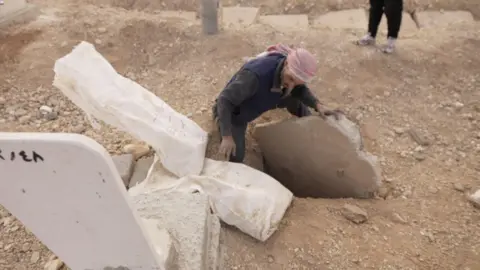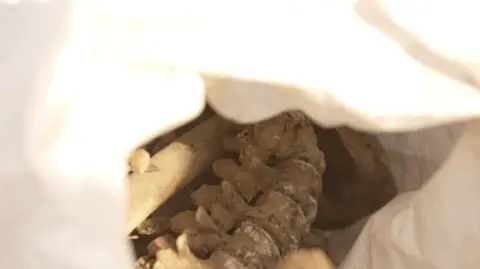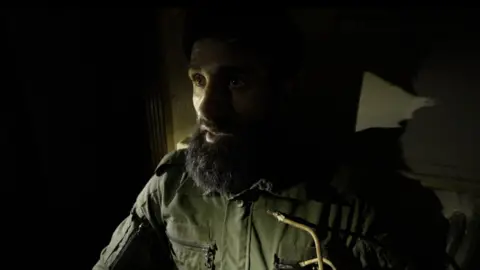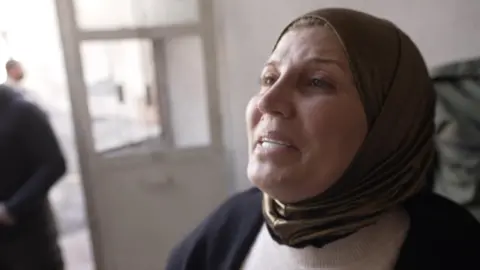
 BBC
BBCAdra is a strange cemetery in the neighbourhood, with two lone graves in an empty space of rough ground, sparsely covered with grass.
For many years, this area was under tight control by the forces of President Bashar al-Assad.
Now, a week after their escape, a concrete slab in one corner of this empty cemetery has been moved to reveal a shallow grave containing at least six white bags, with the names and prison numbers written on them.
Khaled Al-Hamad, a nearby resident, was desperately pulling bags when we arrived.
He shows us the three that he has already opened. Each contains a human skull and bones. The writing on the bags indicates that they are the remains of two female prisoners and one man.
It is not clear how they died, or whether this is evidence of criminal abuses by the Assad regime.
But Khaled does not need convincing. He is searching for his two brothers, Jihad and Hussein, who were kidnapped by Assad's notorious Air Force Intelligence a decade ago. They have not been heard from since.

He added: “Some people were taken to an area called the driving school and were liquidated there.” “I expect that's what happened to my brothers. They might be in some of these bags buried here.”
We shared this information with Human Rights Watch in Syria, which said it was investigating reports of prisoner remains being dumped in similar bags elsewhere.
Assad's fall has unleashed a tsunami of hope for families who have been left for decades with no way of knowing what happened to their loved ones.
“If you passed here (during Assad’s time), you couldn’t stop, you couldn’t look up,” Khaled said.
“The cars were passing by so fast. If you stopped, they would come to you, put a plastic bag on your head and take you away.”
Tens of thousands of families like his are now searching for relatives who disappeared in Assad's notorious prison system, or in military interrogation centres.
Some of them were transferred to the Mezzeh Military Air Base in Damascus.

This site, once a key buffer zone between Assad and rebel forces, is abandoned. Discarded military boots litter the tarmac, a live missile lies on the ground, and the only signs of life are the new guards at the gate: young militiamen from Hay'at Tahrir al-Sham, the group that has taken control of Syria. Last week.
They show us the torture chamber used by Assad's forces – including a metal pole to secure prisoners' feet for beatings, and a set of wires next to an electrical switchboard.
The commander of the guards, Abu Jarrah, told me: “Here they electrocuted the prisoners.” “These are electrical cables – the interrogator sits here, and the guards place them on the prisoner's body and turn on the electricity.
“The prisoner loses his mind and confesses everything. They tell the investigator to write whatever he wants, hoping he will stop.”
Abu Jarrah also said that the 400 women detained here were routinely raped, and that children were born in the prison.
The only thing more painful than finding your parent or child among the records here is not finding them at all.
In the building next door, families search desperately for miniature photos scattered in piles on the concrete floor – face after face staring at silent, grim witnesses to Assad's years of rule.

The mother of Mahmoud Saeed Hussein, a Kurd from Qamishli, was crying.
“We saw yesterday that he was registered at the air base prison,” she told me. “We came and could not find him. I have been looking for him for 11 years, looking from one prison to another.”
“These are all like my son,” she cried, pointing to the piles of pictures on the floor. “God burned the lion’s heart just as He burned our hearts.”
Behind them, three rooms were crammed to the rafters with files open on each other, one after the other. Several people sit on a mountain of documents several feet high covering the floor.
The Assad regime has been meticulous in documenting its brutality – the massive bureaucracy of terrorism makes the scale of its actions abundantly clear, but the stories of individuals often get lost or drowned out.

“What are these notes?” One woman got angry. “No one is helping us. We want someone to come and check these documents with us. How can I find him among these many prison files?”
The lack of any organized system means important evidence is lost every day at sites across Syria – information about missing persons, but also potentially any links between the Assad regime and foreign governments such as the US or UK, both of which have been accused of crimes. Taking advantage of the US extraordinary deportation policy, through which terrorist suspects are sent for interrogation in countries that use torture.
Human rights groups accused the UK government of turning a blind eye to US practices during the so-called war on terrorism, when America sent detainees to several countries in the Middle East, including Syria.
Outside, the silent hangars of the air base are scattered with the remains of Russian-made planes and radars that have been subjected to repeated Israeli air strikes over the past week.
Assad's departure has changed the delicate balance of power between Syria's warring groups and their various international backers, including Türkiye, Iran, and the United States.
This was never just a Syria war, and outside powers still have a stake in what happens here.
The Syrians insist that the time has come for them to govern themselves without anyone telling them what to do.
As we leave, a young fighter from Hay'at Tahrir al-Sham climbs onto the roof to cut down the picture of Assad hanging above the interrogation building.
He smiles at the comrades watching him from below, while photos and documents from the regime's military files flutter around their shoes.
The fall of Assad has raised as yet unanswered questions about Syria's future, but it has also left many questions of the past unanswered.









